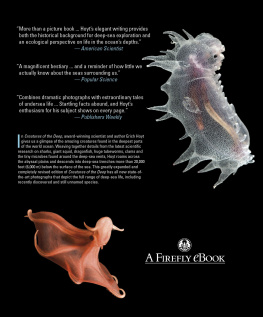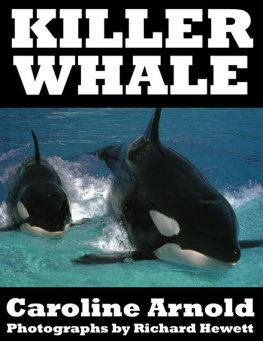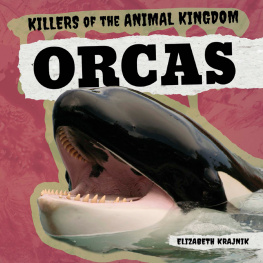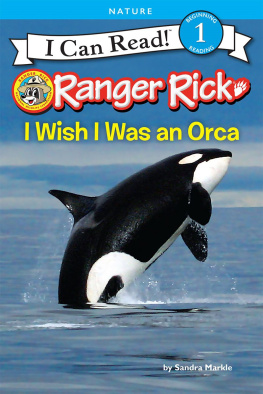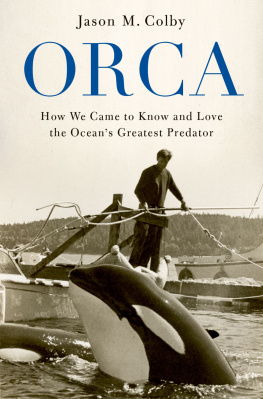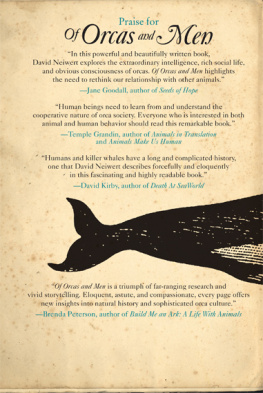FOREWORD
By Sir Peter Scott
Erich Hoyt's book is a splendid introduction to one of the most fascinating and charismatic animals in the world. He blends the story of his exciting adventures working with orcas off the coast of British Columbia with plenty of facts about their behaviour and natural history, which makes a most readable mixture.
Whales and dolphins are all highly intelligent, but orcas are perhaps the most intelligent. Hence, the interactions between people and orcas are extraordinary. Humans and orcas, for example, are curious about one another: they investigate each other, they sing to each other, and they copy each other's tunes. One difference is that while both are among the top predators, orcas never kill men, but men still kill orcas.
As Erich Hoyt acknowledges, the public attitude toward orcas has changed over the last 20 years, partly because the whales have been widely exhibited in aquariums. Familiarity has bred affection, and fear has been replaced with respect. However, I am uneasy about keeping these powerful animals in concrete swimming pools and making a lot of money out of doing so. The aquarium owners justify this by saying they are teaching people about whales and dolphins, but the price for the orcas is particularly high. It must be preferable for people to see whales and dolphins swimming freely in the sea, and I hope that more and more people will be able to do so from boats whose skippers know how to get close to these exciting animals without disturbing them. Erich Hoyt's book shows in vivid detail how much more can be learned this way.
On August 29, 1989, only days after writing this foreword for the third edition, Sir Peter Scott died at his home in England at age 79. As a founder of the World Wildlife Fund and the Wildfowl and Wetlands Trust and, more recently, as president of the Whale and Dolphin Conservation Society, Sir Peter devoted his life to conservation, using his talents as an ecologist, ornithologist, painter, writer and broadcaster. He was the first Briton to be knighted for services to conservation. The fruits of his efforts remain all around us and in the way we think. He has sharpened our awareness of the urgency to act on behalf of the Earth.
PROLOGUE
I knew almost nothing about killer whales in June 1973 when I joined a sailing expedition along Canada's Pacific coast. We were to make a documentary film about killer whales. At that time, they had never been filmed in their natural habitat and had only rarely been observed at close range. Our three-month voyage, sponsored by the University of Victoria and funded by the Canadian government, sailed east, then north from Victoria, combing British Columbia's rainy and remote coastal inlets.
As sound man, my job was to record the whales' underwater "voices" with hydrophones (underwater microphones). Later, there would be the usual duties of recording a sound track complete with narration, sound effects and music to match the film. I had brought along my electronic music synthesizer, which, when connected to an underwater speaker mounted on the hull, would broadcast sounds to the whales. Although I had written jazz and electronic film scores, devising music to entertain whales was something new. Killer whales in captivity are known to be curious about man-made sounds. Maybe wild whales would be too. It was far beyond our modest budget to try to lure these big carnivores with bucket loads of live or freshly killed fish, but perhaps music piped into their underwater world would draw them in close enough for our cameras. It seemed very chancy, even to me.
Back then, I could not anticipate the depth of my involvement with the whales. I could not have imagined that 10 summers later, I would still be making an annual pilgrimage to visit them.
My first task, after I had decided to join the expedition, was to learn everything I could about the killer whale, Orcinus orca. To my surprise, I found no books devoted to the subject. The articles that I uncovered dealt mainly with how little was known about the species. Yet I did learn a few basic facts:
- Killer whales are the top predator in the sea, possessing 10 to 13 interlocking pairs of conical teeth in each jaw usually 48 in all.
- The male orca attains a mature length of about 23 feet; the mature female averages less than 20 feet. The species record is 31 1/2 feet small compared with the 50-to-90-foot lengths of the great whales.
- They are among the ocean's fastest creatures, capable of speeds of up to 30 miles per hour.
- They have no enemies (except man).
Killer whales also have a number of attributes common to other whales and dolphins:
- They are social mammals that eat, sleep, play and travel together in family groups, called pods.
- They have large, complex brains, but no one knows what they use them for.
- They possess all the human senses except smell but are essentially sonic creatures that apparently use sound to navigate, hunt and communicate with each other.
For the most part, I found that scientific studies on Orcinus orca in its natural habitat had been confined to examination of stomach contents and to accounts of the animal's attacking behaviour. In storybook tales, orcas are the monsters of the deep, always chewing up boats and sending terrified sailors to hasty funerals at sea. Anything that lived in, visited or fell into the sea according to these grim stories was food for orca. There was a grain of truth to many of the stories.
Probably the first published account of orca comes from the Roman scholar Pliny the Elder, who wrote in the first century A.D. in Volume IX of his Natural History: "A killer whale cannot be properly depicted or described except as an enormous mass of flesh armed with savage teeth." He called orca "the enemy of other whales" and described scenes in which orcas would "burst into [the other whales'] retreats ... bite and mangle the females and their calves ... and charge and pierce them like warships ramming."
The Latin word orcinus means "of or belonging to the realms of the dead," and orca denotes "a kind of whale." Hence, "killer whale." To the Romans, orca represented a single species the killer whale. During the Middle Ages, orca degenerated to a "sea monster of indeterminate species." The real orca's reputation worsened. In 1598, the English poet Josuah Sylvester wrote: "Insatiable orque [orca], that even at one repast almost all creatures in the world would waste!"
Pliny's view of orca as a savage killer was based on secondhand information, although he had apparently once seen an orca in the harbour at Ostia, near Rome. Emperor Claudius, who was supervising the building of a new pier at the time, led his Praetorian guards in an attack on the hapless creature, spearing it "for to show a pleasing sight to the people of Rome." Pliny's description of orcas killing other whales in the first century resembles modem accounts of killer whales feeding. But Pliny viewed predatory behaviour as a cruel act of violence, as did many of his untrained successors. These accounts gave orca its "killer" reputation, similar to that historically given to other large predators, like the wolf.
Killer whales also eat dolphins. The earlier Greeks, including Aristotle, immortalized the dolphin in their stories of dolphins saving drowning humans and playing with children. They knew that the dolphin was "intelligent" and recognized its altruistic nature. To see a dolphin was an omen of good fortune; to kill one, a curse. The dolphin-loving Greeks and, to a lesser extent, Pliny and the Romans did not take kindly to the dolphin-killing orca. Paradoxically, the killer whale is classified today as a dolphin. All dolphins are toothed whales, Odontoceti, and the killer whale is the largest member of the family of oceanic dolphins, Delphinidae.


